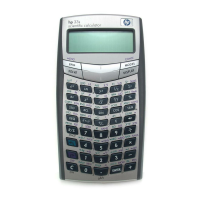Simple Programming
12–13
File name 33s-E-Manual-1008-Publication(1st).doc Page : 386
Printed Date : 2003/10/8 Size : 13.7 x 21.2 cm
For example, see the
"
Coordinate Transformations" program in chapter 15.
Routine D collects all the necessary input for the variables M, N, and T (lines
D0002 through D0004) that define the x and y coordinates and angle
θ
of a new
system.
To respond to a prompt:
When you run the program, it will stop at each INPUT and prompt you for that
variable, such as
. The value displayed (and the contents of the
X–register) will be the current contents of R.
To leave the number unchanged, just press
¥
.
To change the number, type the new number and press
¥
. This new
number writes over the old value in the X–register. You can enter a number as
a fraction if you want. If you need to calculate a number, use normal
keyboard calculations, then press
¥
. For example, you can press 2
Ï
5
)
¥
.
To calculate with the displayed number, press
Ï
before
typing another number.
To cancel the INPUT prompt, press
Å
. The current value for the
variable remains in the X–register. If you press
¥
to resume the program,
the canceled INPUT prompt is repeated. If you press
Å
during digit entry, it
clears the number to zero. Press
Å
again to cancel the INPUT prompt.
To display digits hidden by the prompt, press
º
Î
. (If
it is a binary number with more than 12 digits, use the
Ö
and
Õ
keys
to see the rest.)
Using VIEW for Displaying Data
The programmed VIEW instruction (
º
È
variable ) stops a running
program and displays and identifies the contents of the given variable, such as
This is a display only, and does not copy the number to the X–register. If
Fraction–display mode is active, the value is displayed as a fraction.
Pressing
Ï
copies this number to the X–register.

